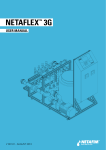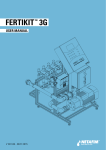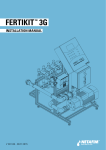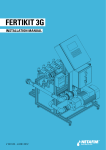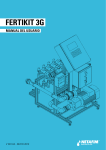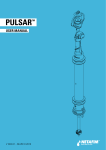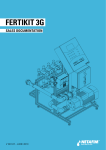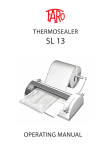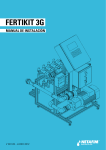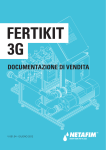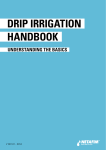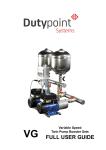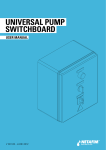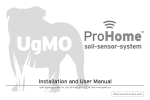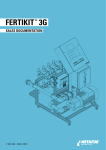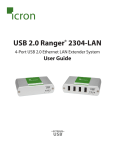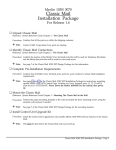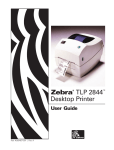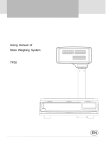Download USER MANUAL 20.04.2012.indd
Transcript
FERTIKIT 3G USER MANUAL V 001.03 - APRIL 2012 © COPYRIGHT 2012, NETAFIM NO PARTS OF THIS PUBLICATION MAY BE REPRODUCED, STORED IN AN AUTOMATED DATA FILE OR MADE PUBLIC IN ANY FORM OR BY ANY MEANS, WHETHER ELECTRONIC, MECHANICAL, BY PHOTOCOPYING, RECORDING OR IN ANY OTHER MANNER WITHOUT PRIOR WRITTEN PERMISSION OF THE PUBLISHER. ALTHOUGH NETAFIM TAKES THE GREATEST POSSIBLE CARE IN DESIGNING AND PRODUCING BOTH ITS PRODUCTS AND THE ASSOCIATED DOCUMENTATION, THEY MAY STILL INCLUDE FAULTS. NETAFIM WILL NOT ACCEPT RESPONSIBILITY FOR DAMAGE RESULTING FROM THE USE OF NETAFIM'S PRODUCTS OR THE USE OF THIS MANUAL. NETAFIM RESERVES THE RIGHT TO MAKE CHANGES AND IMPROVEMENTS TO ITS PRODUCTS AND/OR THE ASSOCIATED DOCUMENTATION WITHOUT PRIOR NOTICE. CONTENTS Use of symbols 5 Safety Safety instructions When using acid/chemicals 6 7 Description Introduction Advantages Basic functions Operating principle Specifications Add-ons Typical installation overview The 4 modes Dimensions Weights 8 8 8 8 9 9 10 10 15 15 Operation, maintenance and winterization Operation Maintenance Winterization 16 17 18 Troublehooting Symptoms regarding more than one single dosing channel Symptoms regarding a single dosing channel Symptoms while idle Switchboard warning Warranty 19 20 21 22 23 Appendices Appendix 1 - Calibration: 1. Calculation of dosing channels opening percentage 2. Simulation with a 10 liter (2 US gal) bucket of water 3. Calibration of the FERTIKIT while irrigating 4 FERTIKIT USER MANUAL 24 24 26 USE OF SYMBOLS The symbols used in this manual refer to the following: WARNING The following text contains instructions aimed at preventing bodily injury or direct damage to the crops, the FERTIKIT and/or the infrastructure. CAUTION The following text contains instructions aimed at preventing unwanted system operation, installation or conditions that, if not followed, might void the warranty. ATTENTION The following text contains instructions aimed at enhancing the efficiency of usage of the instructions in the manual. NOTE The following text contains instructions aimed at emphasizing certain aspect of the operation of the system or installation. EXAMPLE The following text provides an example to clarify the operation of the settings, method of operation or installation. The values used in the examples are hypothetical. Do not apply these values to your own situation. ELECTRICAL HAZARD The following text contains instructions aimed at preventing bodily injury or direct damage to the FERTIKIT and/or the infrastructure in the presence of electricity. ACID HAZARD The following text contains instructions aimed at preventing bodily injury or direct damage to the crops, the FERTIKIT and/or the infrastructure in the presence of acid. SAFETY FOOTWEAR The following text contains instructions aimed at preventing foot injury. TIP The following text provides clarification, tips or useful information. PROTECTIVE EQUIPMENT The following text contains instructions aimed at preventing damage to health or bodily injury in the presence of fertilizers, acid or other chemicals. FERTIKIT USER MANUAL 5 SAFETY Safety instructions • All safety regulations must be applied. • Ensure that the installation is carried out in a manner that prevents leaks from the FERTIKIT, the fertilizer/acid tanks and lines, the peripherals and the accessories, contaminating the environment, soil or ambient area. • Electrical installation must be performed by an authorized electrician only. • The electrical installation must comply with the local safety standards and regulations. • Installation must be performed by authorized technicians only. • Protection provided by the equipment can be impaired if the equipment is used in a manner other than that specified by the manufacturer. WARNING In agricultural environment - always wear protective footwear. WARNING When handling fertilizers, acid and other chemicals, always use protective equipment, gloves and goggles. WARNING Measures must be taken to prevent fertilizer infiltration of the water source. CAUTION When opening or closing any manual valve, always do it gradually, to prevent damage to the system by water hammer. NOTE The maximum sound level produced by the equipment does not exceed 70dB. 6 FERTIKIT USER MANUAL SAFETY When using acid/chemicals ACID HAZARD When using acid/chemicals - always observe the manufacturer's safety instructions. WARNING When handling fertilizers, acid or other chemicals, always use protective equipment, gloves and goggles. ATTENTION Table 1 - When dosing acid, use a dosing channel fitted with the appropriate components according to the type and concentration of the acid used*: Nitric (HNO3 ) Phosphoric (H 3 PO4 ) Sulfuric (H2SO4 ) Hydrochloric (HCl) Hydrogen peroxide (H2O2 ) Chlorine (as hypochloride) Type of dosing channel For diluted acid For concentrated acid For maintenance of drippers Diaphragm and O-rings For pH correction EPDM Viton <3% <40% <85% <85% <30% <90% <10% <33% <30% <50% <1% <10% % is by weight at 21oC (70oF) * The table indicates the resistance of the dosing channel components to acid, and is not a recommendation to use the acids mentioned. WARNING Exceeding the above acid concentrations will damage the dosing channels. WARNING Substances such as chemicals for pest/disease control might be corrosive and damage the FERTIKIT. When using any substance other than fertilizers or acids not exceeding the concentrations in table 1 above, always observe the manufacturer's instructions for corrosivity. In case of any doubt, consult your Netafim representative. FERTIKIT USER MANUAL 7 DESCRIPTION Introduction The FERTIKIT 3G is a fully configurable fertilizer/acid dosing unit - a highly cost-effective solution for precise Nutrigation . Based on a standard platform, the FERTIKIT offers 4 different operation modes, selectable according to the site conditions, in order to maximize usage of available water flow rate and pressure on the main irrigation line, ensuring the highest efficiency with minimum investment. The FERTIKIT can accommodate a variety of dosing channels, dosing boosters, controllers, peripherals and accessories to meet a vast range of applications and infrastructure constraints. TM Advantages • A modular Nutrigation system for soil or substrate applications with minimum investment • Efficient usage of water, fertilizers and energy • Unrivaled range of irrigation water capacities • Designed for any application where quantitative or proportional Nutrigation is required • Highly profitable price/performance ratio • Venturi operating principle - no moving parts • Fits easily into any existing irrigation system • Precise Nutrigation based on high-accuracy dosing channels • Quick action dosing valves • Available with up to 6 fertilizer/acid dosing channels • Nutrigation recipes can be changed quickly and efficiently • Can be operated manually or fully computerized • NMC and other controllers can be assembled on the FERTIKIT for advanced Nutrigation control • A wide variety of accessories and peripherals can be integrated into the FERTIKIT to enhance its functions • High-quality components and PVC pipe work • Aluminum, corrosion-resistant frame with adjustable legs • Easy to install and to maintain • Made by Netafim TM TM TM TM TM Basic functions The FERTIKIT supports the following Nutrigation functions: • Fully controlled dosing and mixing of fertilizers/acid with source water into a homogenous nutrient solution. • EC/pH correction of the nutrient solution. • Water pre-treatment TM Operating principle The FERTIKIT doses the various fertilizers and acid into a homogeneous solution and injects it into the irrigation water main line. The suction of the fertilizers and acid in the dosing channels is based on the Venturi principle. This requires a pressure differentiation - available on the main line or supplied by the main line pump or the FERTIKIT's dosing booster. 8 FERTIKIT USER MANUAL DESCRIPTION Specifications Capacity range The FERTIKIT ensures a satisfactory mixture in an extremely vast range of flow capacities. Examples: It will accommodate a 0.1 Ha (0.25 Acres) nursery or a 400 Ha (1000 Acres) sugar cane plantation. Fertilizer dosing capacity The FERTIKIT's basic platform accommodates up to 6 dosing channels of various types: • 50 l/hr (13 GPH) • 150 l/hr (40 GPH) • 400 l/hr (106 GPH) • 600 l/hr (158 GPH) • 1000 l/hr (265 GPH) * For applications requiring more than 6 dosing channels - consult your Netafim representative. Main line pressure range Typical main line pressure ranges and conditions, by mode: PD - For applications where there is sufficient pressure differentiation on the main line between the source pressure and the required pressure downstream from the FERTIKIT. PL - For applications where the main line pressure is between 2.5 and 6.5 bars (36-94 PSI) and sufficient for irrigation with no excess. PB - For applications where the main line pressure is between 1 and 2.5 bars (14.5-36 PSI) and sufficient for irrigation with no excess. MS - For applications where the pressure downstream the main line pump is between 2 and 8 bars (29-116 PSI). Add-ons You can extend the functionality of your FERTIKIT by means of the many add-ons offering a wide variety of useful functions. All the add-ons are easy to connect to the FERTIKIT - here are a few examples: Fertilizer meter Enables continuous reading of fertilizer dosing. Useful in applications where EC/pH control is not performed. Anti-siphon valve Prevents gravitational flow of fertilizers to the main line when the system is idle. Head control A kit consisting of a water filter, a water meter and a main valve - installable on the main line, providing assigned connectors to the FERTIKIT's inlet and outlet, and assuring full integration with the FERTIKIT. Stock selection Enables the dosing of multiple fertilizers through a single dosing channel (in cases they where simultaneous dosing is not required). Available in a wide variety of configurations, from a single dosing channel with 2 fertilizers to as many dosing channels and fertilizers as required. For further information on the FERTIKIT add-ons - consult your Netafim representative. FERTIKIT USER MANUAL 9 DESCRIPTION Typical installation overview The drawing below represents the infrastructure suitable for the PB and PL modes. The infrastructure for the PD and MS modes is slightly different (see page 11 for PD and page 14 for MS). FERTIKIT 3G Fertilizer/acid stock tank Pressure sustaining valve Main line pump Manual valve (fertilizer) Irrigation valve Pressure reducing valve Fertilizer/acid filter Water meter Manual valve (isolation) Main line filter The 4 modes The FERTIKIT 3G offers 4 different operation modes, selectable according to the site’s conditions, in order to maximize usage of vacant irrigation water flow rate and pressure on the main irrigation line, ensuring the highest efficiency with minimum investment. 10 FERTIKIT USER MANUAL DESCRIPTION PD For applications where there is sufficient pressure differentiation on the main line between the source pressure and the required pressure downstream from the FERTIKIT. Applicable also in cases where there is no electricity on the site. Can be controlled by a DC latch controller, fed by a 12 VDC battery with a solar panel. Saves the need for a dosing booster. Total fertilizer/acid suction capacity - up to 1000 l/hr (265 GPH) Accommodates a wide variety of dosing channels for fertilizer and concentrated/diluted acid: Up to 4 dosing channels, from 50 l/hr (13 GPH) each, up to 250 l/hr (66 GPH) each. Schematic diagram LEGEND scope of delivery direction of flow Irrigation valve Dosing channel + Venturi EC/pH transducer Water meter Upper manifold pressure gauge Fertilizer/acid stock tank Main line filter Lower manifold presure gauge Manual valve (fertilizer) Pressure reducing valve Controller Fertilizer/acid filter Sampling valve EC sensor Manual valve (isolation) Saddle fitting pH sensor Pressure sustaining valve Command tube FERTIKIT USER MANUAL 11 DESCRIPTION PL For applications where the main line pressure is between 2.5 and 6.5 bars (36-94 PSI) and is sufficient for irrigation with no excess. The pressure differentiation required to generate fertilizer suction via the Venturis is produced by a suction pump integrated in the Fertikit. This mode of operation, where the lower manifold is under low pressure (around 0 bar), permits the use of high-efficiency Venturis with high suction capacity and low consumption. Total fertilizer/acid suction capacity - up to 6000 l/hr (1585 GPH) Accommodates a wide variety of dosing channels for fertilizer and concentrated/diluted acid: Up to 6 dosing channels, from 50 l/hr (13 GPH) each, up to 1000 l/hr (265 GPH) each. Schematic diagram LEGEND scope of delivery direction of flow Dosing channel + Venturi Upper manifold pressure gauge Dosing booster Manual valve (isolation) Lower manifold presure gauge Dosing booster switchbox Pressure sustaining valve Sampling valve Check valve Irrigation valve Controller Pressure switch Water meter EC sensor Fertilizer/acid stock tank Main line filter pH sensor Manual valve (fertilizer) Main line pump EC/pH transducer Fertilizer/acid filter Pressure reducing valve 12 FERTIKIT USER MANUAL DESCRIPTION PB For applications where the main line pressure is between 1 and 2.5 bars (14.5-36 PSI) and is sufficient for irrigation with no excess. The pressure differentiation required to generate fertilizer suction via the Venturis is produced by a boost pump integrated in the Fertikit. This mode of operation, where the system pump is installed upstream from the Venturis, permits the use of a smaller pump, reducing the investment required and saving energy. Total fertilizer/acid suction capacity - up to 600 l/hr (158 GPH) Accommodates a wide variety of dosing channels for fertilizer and concentrated/diluted acid: Up to 4 dosing channels, from 50 l/hr (13 GPH) each, up to 150 l/hr (40 GPH) each. Schematic diagram LEGEND scope of delivery direction of flow Dosing channel + Venturi Upper manifold pressure gauge Dosing booster Manual valve (isolation) Lower manifold presure gauge Dosing booster switchbox Pressure sustaining valve Sampling valve Check valve Irrigation valve Controller Pressure switch Water meter EC sensor Fertilizer/acid stock tank Main line filter pH sensor Manual valve (fertilizer) Main line pump EC/pH transducer Fertilizer/acid filter Pressure reducing valve FERTIKIT USER MANUAL 13 DESCRIPTION MS For applications where there is a pump on the main line and it is possible to connect to the main line upstream from the pump. Saves the need for a dosing booster. Total fertilizer/acid suction capacity up to 6000 l/hr (1585 GPH) Accommodates a wide variety of dosing channels for fertilizer and concentrated/diluted acid: Up to 6 dosing channels, from 50 l/hr (13 GPH) each, up to 1000 l/hr (265 GPH) each. Schematic diagram LEGEND scope of delivery direction of flow Dosing channel + Venturi pH sensor Pressure sustaining valve Upper manifold pressure gauge EC/pH transducer Irrigation valve Lower manifold presure gauge Fertilizer/acid stock tank Water meter Sampling valve Manual valve (fertilizer) Main line filter Controller Fertilizer/acid filter Main line pump EC sensor Manual valve (isolation) 14 FERTIKIT USER MANUAL DESCRIPTION Dimensions Without controller H H With controller W W D D Table 2 - Dimensions Configuration Without controller With controller FERTIKIT external dimensions (W/D/H*) Package dimensions (W/D/H**) 84/103/92 cm (33/40.5/36") 100/115/100 cm (39.5/45.5/39.5") 84/103/134.5 cm (33/40.5/53") 100/115/161 cm (39.5/45.5/63.5") *The height varies by ±1 cm (±0.5") according to the adjustment of the legs. **The package height includes the pallet height of 15 cm. Weights° Table 3 - With dosing booster°° 4HM9 Mode Controller PB or PL Without With Net weight 50 kg. (110 lbs.) 60 kg. (132 lbs.) CM5 Packed weight 75 kg. (165 lbs.) 88 kg. (194 lbs.) Net weight 63 kg. (139 lbs.) 73 kg. (161 lbs.) Packed weight 88 kg. (194 lbs.) 101 kg. (223 lbs.) CM15 Net weight 90 kg. (198 lbs.) 100 kg. (220 lbs.) Packed weight 115 kg. (254 lbs.) 128 kg. (282 lbs.) °°Dosing boosters regularly in stock - for the weight of FERTIKITs with other dosing boosters consult your Netafim representative. Table 4 - Without dosing booster Mode Controller PD Without or With MS Net weight Packed weight 33 kg. (73 lbs.) 58 kg. (128 lbs.) 43 kg. (95 lbs.) 71 kg. (157 lbs.) °Order of magnitude only - final weights are issued with the product order. FERTIKIT USER MANUAL 15 OPERATION AND MAINTENANCE Operation The routine operation of the FERTIKIT is almost totally automatic, controlled by the controller (for the operation of the controller, see the Controller Manual). All you need is make sure that: • Electricity is supplied to the FERTIKIT. • Adequate quality water at the appropriate flow rate and pressure is supplied at the inlet of the FERTIKIT (see FERTIKIT Hydraulic Conditions Checklist). • Properly dissolved fertilizers, according to the agronomist's instructions, are constantly present in the stock tanks. • If acid is used - it is constantly present in the acid stock tank and does not exceed the recommended percentage (see table 1, page 7). Dual dosing channel If more than 4 dosing channels are required (up to 6), the dual dosing channel option is used, identifiable by the presence of 2 Venturis connected to a single manifold position. • Up to 2 dual dosing channels can be installed on the FERTIKIT, at the farthest manifold positions (1 and 4). • The dual dosing channel option is applicable only with the 600 l/hr (158 GPH) or the 1000 l/hr (265 GPH) Venturis. LEGEND scope of the dual dosing channel direction of flow CAUTION There are fertilizer combinations that should never be used in the dual dosing channel as they will induce crystalization and cause clogging of the pipes. • Calcium Nitrate + Ammonium Sulfate => Calcium Sulfate • Calcium Nitrate + Potassium Sulfate => Calcium Sulfate • MKP + Calcium Nitrate => Calcium Phosphate • MAP + Calcium Nitrate => Calcium Phosphate • Phosphoric acid + Calcium Nitrate => Calcium Phosphate In case of doubt regarding the use of any combination of fertilizers in the dual dosing channel, consult your Netafim representative. 16 FERTIKIT USER MANUAL OPERATION AND MAINTENANCE Maintenance CAUTION When opening or closing any manual valve, always do it gradually, to prevent damage to the system by water hammer. To prevent failures and extend the life cycle of the FERTIKIT, the user must carry out regular maintenance. • Keep the FERTIKIT dosing unit and its immediate environment clean and dry. CAUTION Before calibrating the EC and pH sensors, gradually close the isolation valves and open the sampling valve until the pressure in the system is released. • The FERTIKIT dosing unit and the supply water and irrigation system must be inspected regularly. Table 5 - Regular inspection Description Rinsing of fertilizer filters* Rinsing of supply water filters* Water and fertilizer leak inspection Calibration of the pH sensor Calibration of the EC sensor How often Once a day Once a day Once a week Every 2-4 weeks Every 4 weeks Instructions Visual inspection See the EC/pH Transducer Manual * Manual filters only. Check the FERTIKIT hydraulic conditions every 4 weeks Consult the main line flow meter and pressure gauge, the upper manifold and lower manifold pressure gauges and the Rotameters of the dosing channels, fill in the data on the FERTIKIT Hydraulic Conditions Checklist provided by the installer and make sure that all the hydraulic conditions match the reference data. When verifying the flow rate for each dosing channel, make sure the cursors on all the Rotameters are adjusted. NOTE The Rotameter's sacle is calibrated by the manufacturer for measurement of the flow rate of water (H2O). Certain inacuracies may be observed when the flow rate of liquids with different densities, such as fertilizers and acids, is measured. ATTENTION Once a month, read the measured flow rates of the dosing channels and compare them with the flow rates defined in the controller, to check whether any changes have occurred. FERTIKIT USER MANUAL 17 OPERATION AND MAINTENANCE Winterization CAUTION When opening or closing any manual valve, always do it gradually, to prevent damage to the system by water hammer. In areas susceptible to freezing temperatures, if the system is not required for irrigation during the winter (mainly in open field applications) perform the following procedure to avoid damage caused by freezing when the FERTIKIT is idle for the winter period: At the beginning of winter: • Gradually close the isolation valves and open the sampling valve until the pressure in the system is released. • Remove EC and pH sensors and store the pH sensor immersed in KCL solution (supplied with the sensor) or in calibration buffer 4 at temperature 18-25˚C (64-77˚F). The pH sensor must never be dry (see EC/pH Transducer Manual). • Empty the FERTIKIT of water. At the end of winter: • Reinstall the EC and pH sensors and calibrate them (see EC/pH Transducer Manual). • Gradually open the isolation valves until the pressure in the system is restored. 18 FERTIKIT USER MANUAL TROUBLESHOOTING This chapter is a systematic guide to the actions to be taken in the case of a malfunction of the FERTIKIT. ATTENTION Before proceeding to troubleshoot any malfunction, make sure that: • The controller settings regarding the dosing channels are correct and match the dosing channels of the FERTIKIT (see the Controller Manual). • The controller settings regarding the field valves are correct (see the Controller Manual). Perform the actions in their order of appearance until the malfunction is fixed. If you identify faulty parts - consult your Netafim representative. CAUTION Only qualified electricians are permitted to perform electrical installations and repairs! CAUTION If isolation valves have been installed on the system, ensure that they are in closed position before troubleshooting any hydraulic malfunction. ATTENTION If fertilizers from a different manufacturer have been recently in use and changes in EC and pH are recorded, perform calibration of the system before assuming a malfunction of the FERTIKIT (see Appendix 1 - Calibration, page 24). Symptoms regarding more than one single dosing channel If one or more of the following symptoms occur regarding more than one single dosing channel, perform the actions listed bellow: Controller warnings • Low EC • High pH • Low fertilizer/acid flow rate Rotameter reading • Low fertilizer/acid flow rate Action 1) For controller warnings only - check and calibrate the EC and pH sensors (see the EC/pH Transducer Manual). 2) Have a qualified electrician check that electricity is being supplied to the FERTIKIT and that all the electrical components are properly connected (see the Switchboard Manual). 3) Check that the hydraulic conditions comply with the reference data in the FERTIKIT Hydraulic Conditions Checklist. If NO, restore the original hydraulic conditions according to the reference data in the FERTIKIT Hydraulic Conditions Checklist. If YES or if the malfunction is still not fixed after restoring the original hydraulic conditions, in PL or PB mode - have a qualified electrician check the dosing booster: Does it function? Does it rotate in the correct direction? If not - the electrician should swap between phases L1 and L3 (see the Dosing Booster Manual). FERTIKIT USER MANUAL 19 TROUBLESHOOTING 4) Check for an air pocket in the dosing booster impeller chamber (see the Dosing Booster Manual): Open the FERTIKIT sampling valve until a stable flow, free of air-bubbles, is obtained. 5) If the original hydraulic conditions are still not restored - loosen the dosing booster's bleeding screw and wait until a stable flow, free of air-bubbles, is obtained, then retighten the bleeding screw (see the Dosing Booster Manual). 6) Check the dosing booster's impeller chamber for clogging: If it is clogged - it should be dismantled and thoroughly cleaned (see the Dosing Booster Manual). If after implementing all the above steps the malfunction is still not fixed - consult your Netafim representative. Symptoms regarding a single dosing channel H If one or more of the following symptoms occur regarding a single dosing channel, perform the actions listed bellow: G F Controller warnings • Low EC • High pH • Low fertilizer/acid flow rate E Rotameter reading • Low fertilizer/acid flow rate A B C D Action 1) Check that there is fertilizer/acid solution in the stock tank A . 2) Check that the stock tank manual valve B is in the OPEN position. 3) Check that the fertilizer/acid filter C is clean - If not, it should be dismantled and thoroughly cleaned. 20 FERTIKIT USER MANUAL TROUBLESHOOTING 4) Check the fertilizer/acid line D (from the stock tank to the dosing channel) for leaks and breaches and make sure all the connectors are tightened. 5) Make sure the dosing channel's needle valve E is open according to the reference data in the FERTIKIT Hydraulic Conditions Checklist. 6) Visually check the needle valve E for chemical damage (internal deformation). If internal deformation is present - replace the needle valve. 7) Visually check the needle valve E for clogging. If clogging is present - thoroughly clean the needle valve. 8) Check that the dosing valve F is functioning: With the controller in MANUAL mode, set the dosing valve F to ON (see the Controller Manual). The LED on the dosing valve should be lit. If it is not - have a qualified electrician check the dosing valve's cable for electrical continuity. If the cable is in working order - check the controller (see the Controller Manual). If the controller and the cable are in working order - toggle the dosing valve F to OFF and again to ON in the controller (see the Controller Manual). A "Click" should be heard from the dosing valve with each toggle - If a "Click" is not heard, replace the dosing valve (consult your Netafim representative). If a "Click" is heard and the dosing valve F still does not open - disconnect the dosing valve from the dosing channel and with the dosing valve set to ON in the controller (see the Controller Manual), check for clogging by injecting water at low pressure through the dosing valve. If there is clogging - thoroughly clean the dosing valve F with running water. If there is no clogging and the dosing valve F still does not open - replace it (consult your Netafim representative). 9) Visually check the non-return valve G for any internal deformation or damage to its flat ring gasket. If present - replace the non-return valve (consult your Netafim representative). 10) Check the non-return valve G for clogging by injecting water at low pressure through it (make sure to respect the direction of flow). If there is clogging - thoroughly clean the non-return valve G with running water. 11) Disconnect the Venturi H from the manifolds and from the dosing channel and check it for clogging, visually and by injecting water at low pressure through it. If there is clogging - thoroughly clean the Venturi H with running water. 12) Visually check the Venturi H for chemical damage (internal deformation). If internal deformation is present - replace the Venturi (consult your Netafim representative). If after implementing all the above steps the malfunction is still not fixed - consult your Netafim representative. Symptoms while idle If the following symptoms occur while the FERTIKIT is idle, perform the actions listed bellow: Controller warnings • High EC • Low pH • While idle - Uncontrolled fertilizer/acid flow rate or a fertilizer/acid leak or breach FERTIKIT USER MANUAL 21 TROUBLESHOOTING Action NOTE When using the 1000 l/hr (265 GPH) dosing valve (model: Fip S22), make sure the dosing valve selector is in the CLOSED position. Check if the dosing valves leak when closed: 1) Close all the manual valves B for fertilizers and acid. 2) Make sure the level of the solution in all the the stock tanks is higher than the dosing valves. 3) With the controller in MANUAL mode, set all the dosing valves to OFF (see the Controller Manual). 4) Disconect one of the the dosing valves from the non-return valve (downstream from the dosing valve). 5) Open the fertilizer manual valve B . OPEN CLOSE If a leak from the dosing valve is visible - disconect the dosing valve from the dosing channel. 6) With the controller in MANUAL mode, set the dosing valve to ON (see the Controller Manual). 7) Thoroughly clean the dosing valve with running water. 8) Repeat steps 4-7 for each fertilizer and acid dosing channel. 9) After completing the procedure, open all the manual valves B for fertilizers and acid. 10) If the malfunction is still not fixed - replace the dosing valve. If after implementing all the above steps the malfunction is still not fixed - consult your Netafim representative. Switchboard warning If the following symptom occurs during operation, perform the actions listed bellow: Switchboard warning light • The switchboard warning light is on (When the dosing booster is either ON or OFF). Action 1) Check if the pressure on the main line is low compared with the reference data on the FERTIKIT Hydraulic Conditions Checklist: If YES, restore the original main line pressure. 2) Check if the overload protection breaker is ON (see the Switchboard Manual). Toggle it OFF and ON again. If the switchboard warning light is still on or the overload protection breaker trips (turns to OFF) again, have a qualified electrician check if the dosing booster is in working order (see the Dosing Booster Manual) and check if there are irregularities in the electricity voltage supplied to the FERTIKIT. If after implementing all the above steps the malfunction is still not fixed - consult your Netafim representative. 22 FERTIKIT USER MANUAL WARRANTY Netafim warrants all the components of the FERTIKIT to be free of defects in material and workmanship for 1 (one) year from the date of installation, provided the installation has been reported to Netafim within 30 days of installation. If the installation was not reported or was reported later than 30 days from the date of installation, Netafim will warrant the FERTIKIT for a period of 18 months from the date of production, according to its serial number. If a defect is discovered during the applicable warranty period, Netafim will repair or replace, at its discretion, the product or the defective part. The above does not apply to EC and pH sensors, since they are wearable. Netafim will warrant these items to be free of defects in material and workmanship for 3 months from the date of installation, provided the installation has been reported to Netafim within 30 days, or 6 months from date of production if installation was not reported or was reported later than 30 days from the date of installation. CAUTION When not installed, the pH sensor must be immersed in KCL solution (supplied with the sensor) or in calibration buffer 4 at temperature 18-25˚C (64-77˚F), protected from freezing and not be exposed to pressure greater than 6 bars (87 PSI). Damage due to these causes is not covered by warranty. This warranty does not extend to repairs, adjustments or replacements of a FERTIKIT or part that results from misuse, negligence, alteration, force majeure, lightning, power surge, improper installation or improper maintenance. If a defect arises in your Netafim product during the warranty period, contact your Netafim supplier. Limited warranty This warranty is subject to the conditions in Netafim's official warranty statement. (For the full text of Netafim's official warranty statement, please contact Netafim). FERTIKIT USER MANUAL 23 APPENDIX 1 - CALIBRATION The process of calibrating the FERTIKIT is carried out in three stages: 1. Calculation of dosing channels opening percentage To finely calibrate the FERTIKIT in order to achieve homogeneous and stable dosing, perform the following calculation for each dosing channel (fertilizers and acid) to determine the amount of suction reduction needed to attain the required fertilizer/acid flow rate. Metric units EXAMPLE Flow rate of the largest irrigation shift m3 /hr X Dosing ratio of a single fertilizer/acid l/m 3 = l/hr Result: a single fertilizer/acid flow rate X 1.25 = l/hr Result: target Rotameter reading 120 X 3 = 360 X 1.25 = 450 m3 /hr l/m 3 l/hr l/hr DEFINITION The quantity of fertilizer/acid (l) Dosing ratio = 1 m3 irrigation water US units EXAMPLE GPM Flow rate of the largest irrigation shift X US gal/1000 US gal Dosing ratio of a single fertilizer/acid X 0.06 = GPH Result: a single fertilizer/acid flow rate X 1.25 = Result: target Rotameter reading GPH 500 X 15 X 0.06 = 45 X 1.25 = 56 GPM US gal/1000 US gal GPH GPH DEFINITION The quantity of fertilizer/acid (US gal) Dosing ratio = 1 THG (1000 US gal) irrigation water NOTE The Rotameter's sacle is calibrated by the manufacturer for measurement of the flow rate of water (H2O). Certain inacuracies may be observed when the flow rate of liquids with different densities, such as fertilizers and acids, is measured. 2. Simulation test with a 10 liter (2 US gal) bucket of water Instruments needed • Good-quality portable EC and pH sensors, finely calibrated • Calibration solutions for EC and pH • Bucket with a scale for up to 10 liters (2 US gallons) • Measuring tube or syringe with a scale for up to 100 cc (1 oz) • Clean (preferably distilled) water for cleaning sensors during calibration • Blotting paper for cleaning and drying The client prepares the fertilizer solutions and the acid solution (if required) in the stock tanks according to the recipe advised by the agronomist/consultant. ATTENTION Ensure the fertilizers and acid solutions in the stock tanks have been thoroughly agitated before starting the simulation. 24 FERTIKIT USER MANUAL APPENDIX 1 - CALIBRATION Note the required dosing ratio of each fertilizer solution and the dosing ratio of the acid solution (if used). Fill a bucket with 10 liters (2 US gallons) of the client's supply water (without fertilizer or acid). Measure the EC and the pH levels of the water in the bucket using calibrated portable sensors. EXAMPLE EC Supply water (without fertilizer or acid) 0.3 pH 7.8 Using a measuring tube or a syringe, take a dose from each fertilizer solution and from the acid solution (if used) according to the proportions determined by the dosing ratio (see example below) and mix thoroughly with the water in the bucket. EXAMPLE A Metric units For a fertilizers dosing ratio of 5 l/m 3 each and an acid dosing ratio of 2 l/m3 the quantities for 10 liters of water in the Bucket-simulation-test will be 50 cc of each fertilizer solution and 20 cc of the acid solution B C Acid 10 liters (2 US gal) US units For a fertilizers dosing ratio of 1.5 US gal/THG each and an acid dosing ratio of 1.1 US gal/THG the quantities for 2 US gallons of water in the Bucket-simulation-test will be 0.38 oz* of each fertilizer solution and 0.28 oz** of the acid solution DEFINITIONS 1 US gal = 128 oz * 1.5 X 2 = 0.003 US gal = 0.384 oz 1000 ** 1.1 X 2 = 0.0022 US gal = 0.28 oz 1000 Measure the EC and the pH levels of the mixture in the bucket using calibrated portable sensors. Compare the measured EC and pH values to the target values set by the agronomist/consultant. EXAMPLE After adding the fertilizers and acid Target values Deviation from target value EC 1.6 1.8 11% pH 5.5 5.8 5% In range GOOD! Out of range -30% Target value Out of range +30% FERTIKIT USER MANUAL 25 APPENDIX 1 - CALIBRATION With the controller set to operate according to EC/pH values - if the EC and pH values measured in the bucket are within a range of ±30% deviation from the target values, the system will be able to correct them automatically. If the values are out of the ±30% range, check the data and consult the agronomist/consultant. 3. Calibration of the FERTIKIT while irrigating WARNING Extreme EC or pH values may damage the crop. Perform the following procedure only after completing stage 2 above (Simulation test with a 10 liter or 2 US gallon bucket of water) with satisfactory results. NOTE The following steps explain the operations to be performed, regardless of the type of controller used. For the operation of your controller's interface, consult the Controller Manual. However, since the NMC Pro controller is widely used - its interface screens for the execution of each step are noted. NOTE Before the calibration, confirm that the EC and the pH sensors of the FERTIKIT have been calibrated according to the instructions in the EC/pH Installation Manual. Define the dosing configuration, while the EC and pH controls are in the OFF position (NMC Pro - screen 7.7). In the EC and pH alarm definitions, set the EC and pH alarm to the OFF position (deactivated) (NMC Pro - screen 3.6). Enter the data for the irrigation valves, and the dosing ratio for each dosing channel (NMC Pro - screens 1.1-1.2-1.3). Run the program (NMC Pro - screen 2.2). Allow a few minutes for the pipes to fill up and the flow rate to stabilize. Reduce the suction of the dosing channels by adjusting the manual needle valve of each dosing channel until the "target Rotameter reading" calculated in stage 1 (page 24) is attained. NOTE The Rotameter's sacle is calibrated by the manufacturer for measurement of the flow rate of water (H2O). Certain inacuracies may be observed when the flow rate of liquids with different densities, such as fertilizers and acids, is measured. Check the appropriate controller screen for the measured EC and pH values (NMC Pro - hot screen 4). If the desired values have been reached, check opening percentages of the dosing valves. The EC and pH target values should be attained with the dosing valves opened to 50% - 80% of their capacity. If the EC and pH target values are attained with the dosing valves opened less than 50%, reduce the dosing channel suction rate, until the EC and pH target values are reached. NOTE Every change in the flow rate of the needle valve must be updated afterwards in the controller (NMC Pro - screen 7.6). 26 FERTIKIT USER MANUAL APPENDIX 1 - CALIBRATION If the EC and pH target values cannot be attained, and the dosing valves are opened more than 85%, measures should be taken to increase the dosing ratio - if feasible, slightly increase the concentration of the fertilizer solution and/or reduce the water flow rate to the field during irrigation. If not - consult the agronomist/consultant. In a field where the flow rate changes significantly from one irrigation shift to the next, try to be at a minimum of 50% dosing valve opening for the low flow rate shift, and a maximum of 80% for the high flow rate shift. When the calibration process is completed, return to the EC and pH control screen in the controller, define the deviation in EC and pH values for the channels and switch the EC and pH control to ON (NMC Pro - screen 7.7-7.6). In the EC and pH alarm definitions, define the EC and pH deviation from the target values that, if attained, will trigger the alarm and set the EC and pH alarm to the ON position (activated) (NMC Pro - screen 3.5-3.6). NOTE EC and pH values must not exceed a ±30% deviation from the target values. ATTENTION Once a month, read the measured flow rates of the dosing channels and compare them with the flow rates defined in the controller, in order to check whether changes have occurred (NMC Pro - screen 7.6). After completing the calibration process, fill out the FERTIKIT Hydraulic Conditions Checklist Keep one copy as reference for calibration of the FERTIKIT in the future, and send a copy to cmt.support@netafim.com. FERTIKIT USER MANUAL 27 28 FERTIKIT USER MANUAL GROW MORE WITH LESS WWW.NETAFIM.COM




























